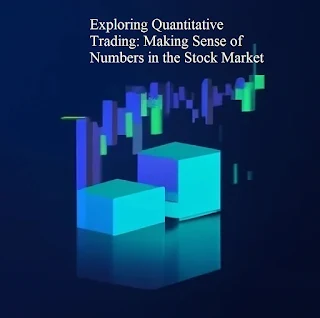Hey young traders! Have you ever wondered how people make decisions about buying and selling stocks? Well, there's a cool way called quantitative trading that uses math and computers to help make those decisions. Let's dive into the world of quantitative trading and see how it works!
What is Quantitative Trading?
Quantitative trading is like using super smart robots to analyze lots of
numbers and patterns in the stock market. Instead of making decisions based on
feelings or guesses, quantitative traders use data and formulas to decide when
to buy or sell stocks. It's all about using math to find patterns that could
help predict what might happen next in the market.
How Does Quantitative Trading Work?
Imagine you have a robot friend named Q-Trader. Q-Trader's job is to look at
a ton of data, like how much a stock's price has changed over time, how many
people are buying or selling it, and even news headlines that might affect the
stock market. Q-Trader uses these numbers to make predictions about which
stocks might go up or down in value.
Examples of Quantitative Trading
Let's look at two examples to understand how quantitative trading can be
used in real life:
Example 1: Moving Average Strategy
Q-Trader uses a strategy called the moving average. This means it looks at
the average price of a stock over a certain period, like the last 50 days. If
the current price of the stock goes above this average, Q-Trader might buy the
stock because it thinks the price could keep going up. If the price drops below
the average, Q-Trader might sell the stock to avoid losing money.
Data Example: Q-Trader analyzed the moving averages of a
popular tech company's stock and found that whenever the price crossed above
its 50-day moving average, the stock tended to rise by an average of 5% over
the next month.
Example 2: Momentum Trading
Another strategy Q-Trader uses is called momentum trading. This means
Q-Trader looks for stocks that have been going up in price consistently. It
thinks these stocks might continue to go up because other traders are also
buying them. Q-Trader buys these stocks and sells them when it thinks the
momentum is slowing down.
Data Example: Q-Trader identified a healthcare company's
stock that had been increasing in price for the past three months. It bought
the stock and sold it after it reached a 20% increase, based on its analysis of
trading volumes and price movements.
Why is Quantitative Trading Important?
Quantitative trading is important because it helps traders make decisions
based on data and statistics rather than emotions. It can help reduce risks and
increase the chances of making profitable trades. By using computers and
algorithms, quantitative traders can analyze vast amounts of information
quickly and efficiently, which would be impossible for humans to do on their
own.
Conclusion
Quantitative trading is like having a super smart assistant that helps
traders make informed decisions in the stock market. It's all about using math,
data, and computers to understand patterns and predict what might happen next.
Whether it's using moving averages to track stock prices or momentum trading to
follow trends, quantitative trading helps traders navigate the complexities of
the financial world.
So, next time you hear about quantitative trading, remember how it uses
numbers and algorithms to make sense of the stock market. Who knows, maybe one
day you'll use your math skills to become a quantitative trader yourself and
make a big impact in the world of finance!
Keep exploring and learning about how math and technology shape our world.
Understanding topics like quantitative trading opens doors to exciting
possibilities and careers in the future.
Until next time, happy trading!

Comments
Post a Comment